
Ampelosaurus is a titanosaurian sauropod dinosaur from the Late Cretaceous Period of what is now France. Its type species is A. atacis, named by Le Loeuff in 1995. Its remains were found in a level dating from 71.5 million years ago representing the early Maastrichtian.

Doratodon is an extinct genus of Late Cretaceous crocodylomorph that may have been a member of the Sebecosuchia. Doratodon was a relatively small animal with ziphodont teeth, meaning the teeth had flattened sides and serrated edges. Two species of Doratodon are known to science: D. carcharidens from Austria and Hungary, the type species; and D. ibericus from Spain. Teeth similar to those of Doratodon are also known from Italy and Romania, though they cannot be confidently assigned to this genus.

Allodaposuchus is an extinct genus of crocodyliforms that lived in what is now southern Europe during the Campanian and Maastrichtian stages of the Late Cretaceous. Although generally classified as a non-crocodylian eusuchian crocodylomorph, it is sometimes placed as one of the earliest true crocodylians. Allodaposuchus is one of the most common Late Cretaceous crocodylomorphs from Europe, with fossils known from Romania, Spain, and France.
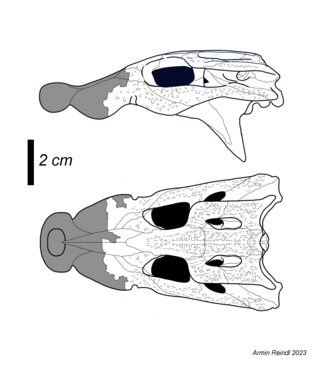
Trilophosuchus is an extinct genus of mekosuchine crocodilian from Australia. Its fossils have been found at the Ringtail Site in the Riversleigh World Heritage Area and date to the Miocene epoch. Additional remains have also been found at the older Hiatus Site and extend its range into the Oligocene. Like the closely related Mekosuchus, it is thought to have had a short and blunt snout and large eyes that generally resembles today's dwarf crocodiles. It also shares similarities with several much older crocodylomorph groups and is commonly thought to have been more terrestrial than any crocodilian living today. Only a single species has been described, the type species T. rackhami.
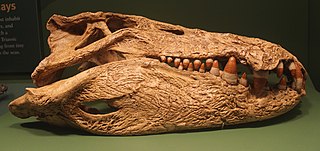
Mahajangasuchus is an extinct genus of crocodyliform which had blunt, conical teeth. The type species, M. insignis, lived during the Late Cretaceous; its fossils have been found in the Maevarano Formation in northern Madagascar. It was a fairly large predator, measuring up to 4 metres (13 ft) long.
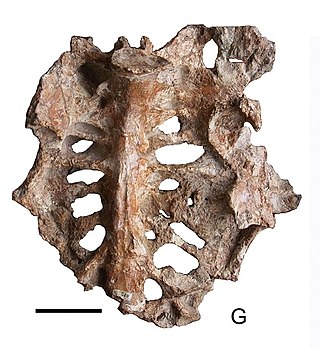
Gargantuavis is an extinct genus of large, primitive bird containing the single species Gargantuavis philoinos. It is the only member of the monotypic family Gargantuaviidae. Its fossils were discovered in several formations dating to 73.5 and 71.5 million years ago in what is now northern Spain, southern France, and Romania. Gargantuavis is the largest known bird of the Mesozoic, a size ranging between the cassowary and the ostrich, and a mass of 141 kg (311 lb) like modern ostriches, exemplifying the extinction of non-avian dinosaurs was not a necessary condition for the emergence of giant terrestrial birds. It was once thought to be closely related to modern birds, but the 2019 discovery of a pelvis from what was Hateg Island shows several primitive features.

Acynodon is an extinct genus of eusuchian crocodylomorph from the Late Cretaceous, with fossils found throughout Southern Europe.
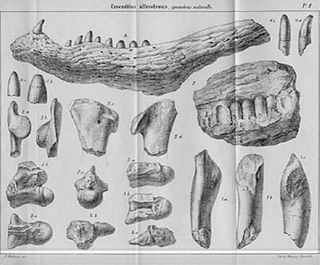
Massaliasuchus is an extinct monospecific genus of allodaposuchid eusuchian crocodyliform that is known from fossils found in Santonian–Campanian-age Upper Cretaceous rocks of southeastern France.
Heterosuchus is an extinct genus of crocodylomorph that may have been a eusuchian. It is known only from neck and back vertebrae recovered from Early Cretaceous-age rocks of the Hastings Beds of Hastings, Sussex. These vertebrae are procoelous, which is a trait of eusuchians. Heterosuchus was described by Harry Seeley in 1887, with H. valdensis as the type species. It may be the same genus as the slightly younger Hylaeochampsa, inferred to have been of similar evolutionary grade, but there is no overlapping material as Hylaeochampsa is known only from a partial skull; Hylaeochampsa would be the name used for both in that case, because it is the older name. Because of the sparse material and apparent lack of distinguishing characteristics, James Clark and Mark Norell (1992) considered Heterosuchus a dubious name.

Musturzabalsuchus is an extinct monospecific genus of allodaposuchid eusuchian crocodyliform. The type and only species is Musturzabalsuchus buffetauti.

Ischyrochampsa is an extinct monospecific genus of Late Cretaceous crocodyliform belonging to the eusuchian clade Allodaposuchidae. Fossils of the type species I. meridionalis are late Campanian in age and were found in the commune of Saint-Estève-Janson in Bouches-du-Rhône, France. Material is also known from Spain. It was named and described in 1995, and it had an estimated length of over 4 metres (13 ft).
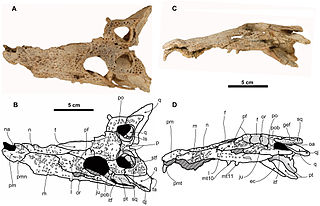
Arenysuchus is an extinct monospecific genus of allodaposuchid eusuchian crocodylomorph from Late Cretaceous deposits of north Spain. It is known from the holotype MPZ ELI-1, a partial skull from Elías site, and from the referred material MPZ2010/948, MPZ2010/949, MPZ2010/950 and MPZ2010/951, four teeth from Blasi 2 site. It was found by the researchers José Manuel Gasca and Ainara Badiola from the Tremp Formation, in Arén of Huesca, Spain. It was first named by Eduardo Puértolas, José I. Canudo and Penélope Cruzado-Caballero in 2011 and the type species is Arenysuchus gascabadiolorum.

Pissarrachampsa is an extinct genus of baurusuchid mesoeucrocodylian from the Late Cretaceous of Brazil. It is based on a nearly complete skull and a referred partial skull and lower jaw from the ?Campanian - ?Maastrichtian-age Vale do Rio do Peixe Formation of the Bauru Group, found in the vicinity of Gurinhatã, Brazil.

Planocraniidae is an extinct family of eusuchian crocodyliforms known from the Paleogene of Asia, Europe and North America. The family was coined by Li in 1976, and contains three genera, Boverisuchus, Duerosuchus and Planocrania. Planocraniids were highly specialized crocodyliforms that were adapted to living on land. They had extensive body armor, long legs, and blunt claws resembling hooves, and are sometimes informally called "hoofed crocodiles".

Allodaposuchidae is an extinct clade of eusuchians that lived in Europe during the Late Cretaceous (Santonian-Maastrichtian).

Matheronodon is a genus of rhabdodontid ornithopod dinosaur from the late Cretaceous Period of the Grès à Reptiles Formation in France. The genus contains a single species, M. provincialis, which is known from a single maxilla and associated teeth. It was named by Pascal Godefroit and colleagues in 2017. The teeth of Matheronodon are large but few in number. The teeth are also in an unusual arrangement, emerging alternatingly from one of a pair of fused tooth sockets in its mouth. In life, the teeth would have functioned like a pair of scissors, allowing Matheronodon to feed on the tough leaves of monocot plants.
Oardasaurus is an extinct genus of lizard from the latest Cretaceous of Romania. It is a member of the Barbatteiidae, a group of lizards closely related to the Teiidae. At 20 centimetres (7.9 in) in length, it was much smaller than the only other named member of the Barbatteiidae, Barbatteius, which lived slightly later. Like Barbatteius, Oardasaurus can be identified by the presence of a crust of bone deposits, or osteoderms, on the roof of its skull; it differs from Barbatteius in the pattern of the sculpturing on this crust. Both Oardasaurus and Barbatteius lived in the isolated island ecosystem of Hațeg Island, having rapidly diversified into various generalist predators of small prey after their arrival on the island during the Early Cretaceous. They went extinct in the Cretaceous–Paleogene extinction event.

Lohuecosuchus is an extinct genus of allodaposuchid eusuchian crocodylomorph that lived during the Late Cretaceous in what is now Spain and southern France.
Aprosuchus is a genus of small-bodied Maastrichtian atoposaurid Eusuchian from the Hateg Basin, Romania.
Titanochampsa is a genus of large mesoeucrocodylian from the Maastrichtian Marilia Formation of Brazil. Although only known from a single skull roof, the material shows that Titanochampsa was not a member of Notosuchia, which were previously believed to have been the only crocodyliforms present in the strata of the Bauru Group. Body size estimates vary greatly and range between 2.98–5.88 m due to the incomplete nature of the holotype fossil. The overall anatomy of the skull roof, alongside its size and possible affinities with Neosuchians, may suggest that it was a semi-aquatic ambush hunter similar to modern crocodilians.


















